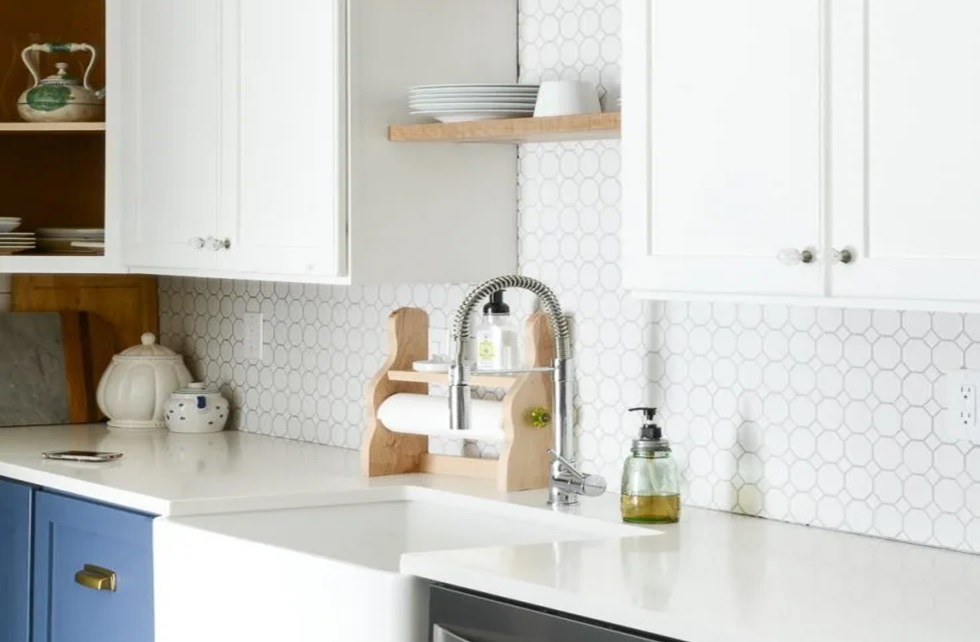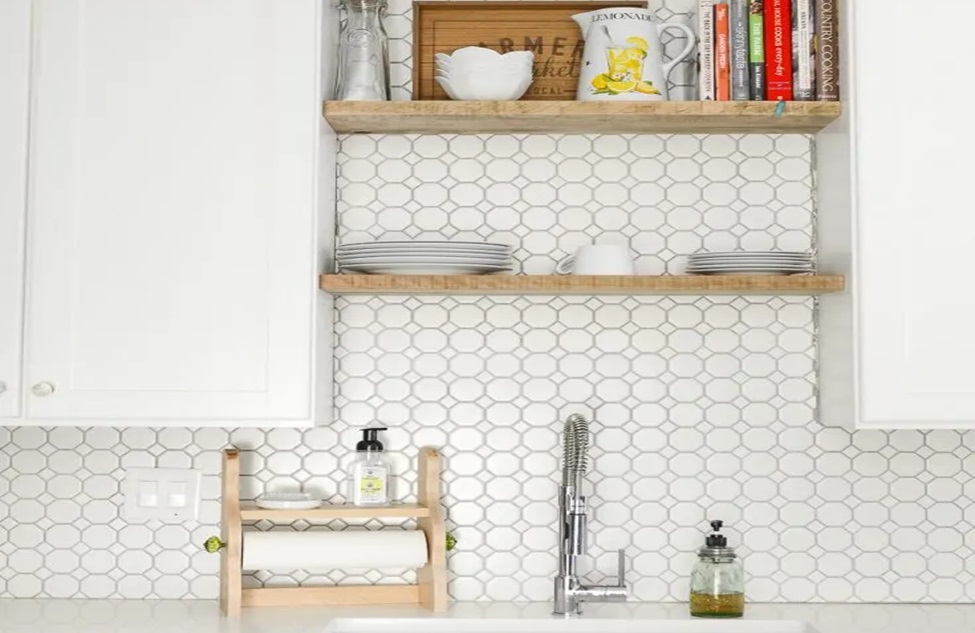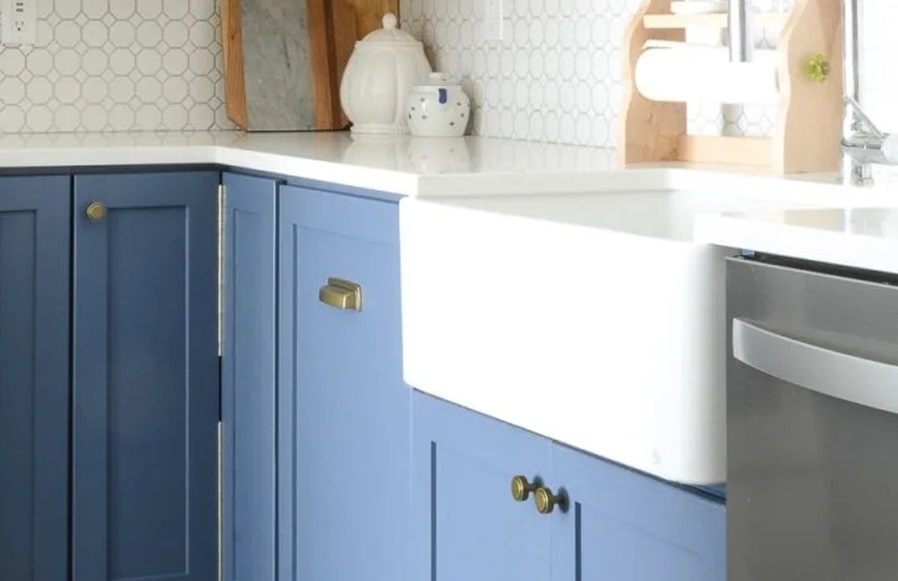If you’re considering a farmhouse sink for your kitchen, there are a few key points to keep in mind before making your purchase.
It’s been more than a year since we completed our Blue & White two-toned kitchen renovation. Despite the challenges, I’ve never regretted the excitement of remodeling our kitchen.
While I adore our farmhouse sink, there were a few surprises we encountered during the renovation process. Large apron-front sinks differ from standard sinks in several ways. Here are some insights I wish I had known before investing in a farmhouse sink.
Farmhouse sinks are not cheap
My dream was to have a large, single-basin, white apron-front sink. These sinks typically range from $1000 to $2000, which is about what we spent on all the wood needed to build cabinets for our entire kitchen!
After doing plenty of research, I found a wonderful, more budget-friendly farmhouse sink that I absolutely love. However, it still cost us over $500 for just the sink.
If a traditional farmhouse sink isn’t within your budget, don’t worry. There are other options available. Stainless steel apron-front sinks, for instance, can be found at much lower prices.
Ikea also offers an apron-front white sink option, although it’s not as deep as a traditional farmhouse sink and comes with a sink divider. They do have a new, smaller version without a sink divider, though.
Be aware of hidden costs
When tackling a kitchen remodel or refresh, it’s crucial to stick to a budget. If you’re considering adding a farmhouse sink to your kitchen, it’s wise to be aware of potential hidden costs so you can budget accordingly. We were caught off guard a few times by unexpected expenses.
If you’re planning to install a garbage disposal with your farmhouse sink, you’ll likely need to purchase an extended flange to attach it properly. Most farmhouse sinks have extra thickness, making a standard flange incompatible.
You might assume a flange wouldn’t break the bank, but in my search, I found that it can be quite pricey. In fact, the extended flange can cost almost as much as the garbage disposal itself, so it’s best to be prepared.
Additionally, because farmhouse sinks are typically deeper than standard sinks, you may need to make plumbing adjustments to ensure proper drainage. Luckily, our previous sink had one higher drain and one lower, allowing us to utilize the lower drain. However, if that hadn’t been the case, we would have needed to hire a plumber, which can add up in expenses.
Farmhouse sinks are large

I understand it might seem obvious that farmhouse sinks are large – after all, that’s part of their charm. But I didn’t fully grasp just how sizable it would be until it was installed.
Filling the sink with water takes a significant amount of time, and draining it is equally time-consuming. When I only have a few items to wash, like dishes or fruits, I find it more convenient to use a large bowl in the sink instead of filling it up entirely.
Because of its size, the farmhouse sink eats up a lot of the storage space underneath. Adding a garbage disposal only exacerbates this issue, and it’s crucial to measure the under-sink area carefully to ensure the new disposal fits snugly.
We’ve had to get inventive with our under-sink storage to accommodate everything. Some items had to be relocated to the linen closet to make it all work.
Dishes are easier to break
For some reason, we’ve noticed a significant increase in broken dishes in our farmhouse sink over the past year compared to our standard porcelain sink, which lasted us 15 years without incident.
I believe the deeper design of the farmhouse sink plays a role here. When something slips from your hand, it has a longer distance to fall, increasing the chances of breakage. Additionally, the spacious bottom of the sink makes it easier for items to topple over.
After a mishap where the lid of my $250 Le Creuset casserole dish shattered at the bottom of the sink (fortunately, the sink itself remained intact), I invested in a sink bottom grid. Since installing it, we haven’t had a single broken dish incident!
However, cleaning the rack and the sink underneath it can be a bit of a hassle. To keep things manageable, I make sure to rinse the sink well after each use (which can be challenging with kids around) and give it a thorough scrub once a week.
White sinks stain easily
The issues related to sink maintenance aren’t exclusive to farmhouse sinks; we experienced similar challenges with our traditional 2-basin porcelain sink. However, these points are worth highlighting, especially for those accustomed to the easier upkeep of stainless steel sinks.
Once again, ensuring thorough rinsing after each use is essential for minimizing staining. Employing a sink bottom grid can help prevent dishes from scratching the sink surface, as scratches tend to trap dirt and lead to faster staining.
It’s crucial to avoid leaving metal dishes in the sink for prolonged periods. We learned this the hard way when the feet of our cooling rack caused rust spots in our beautiful white sink.
Fortunately, stains aren’t always permanent. A weekly deep cleaning session using a microfiber cloth and our favorite cleaner, Branch Basics All Purpose mixed with their Oxygen Boost, has proven effective. This cleaner isn’t just non-toxic – it also leaves our fireclay sink looking bright white and free from stains.
Installation can be tricky

Many contractors are said to dislike installing farmhouse sinks due to the complexities involved. However, we opted to install our own sink and found the process manageable.
To streamline the installation, we constructed the sink base cabinet according to the sink specifications (I also built our kitchen cabinets). This eliminated the need for any modifications to the cabinets.
Next, we installed 2×4 braces directly into the cabinets after they were in place. Ensuring everything was level required extra time and attention to detail.
Farmhouse sinks are exceptionally heavy, especially when filled with water, as I mentioned earlier. Poor installation can lead to cracks, particularly with fireclay sinks.
We conducted thorough research before attempting our DIY farmhouse sink installation and took the time to double-check everything along the way. Thanks to our diligence, we encountered no issues, and I would happily install a farmhouse sink again!
Why I Love My Farmhouse Sink
These points to consider before purchasing a large apron-front sink aren’t meant to discourage you. In fact, with each day of use, my appreciation for it grows stronger.
We’ve found countless uses for the spacious basin, and the impressive sink never fails to draw admiration from visitors. So, I’d like to conclude with the top reason why you’ll also fall in love with your farmhouse sink.
5 Reasons to Choose a Farmhouse Sink
- The spacious, deep sink bowl simplifies filling and cleaning large pots and pans.
- Conveniently bathe babies or small animals in the kitchen sink without the need to bend over a tub.
- With the sink front at belly level, there’s no leaning over the counter as with a standard sink, reducing back strain.
- Hide numerous dirty dishes in the sink when guests are on their way.
- The stunning white apron serves as a statement piece for your kitchen.
If you’ve been contemplating a large, gorgeous farmhouse sink for your kitchen, I hope this information has shed light on the potential challenges it entails. Being well-informed as a buyer and DIY enthusiast is far preferable to finding yourself in an unprepared situation.
Conclusion
While farmhouse sinks offer numerous benefits such as ample space, convenience, and aesthetic appeal, it’s essential to weigh the potential challenges and considerations discussed. Being prepared and informed about the installation process, maintenance requirements, and adjustments needed in your kitchen layout can help you make the most of your farmhouse sink investment. Ultimately, with careful planning and attention to detail, a farmhouse sink can become a beloved centerpiece in your kitchen, enhancing both its functionality and charm for years to come.











